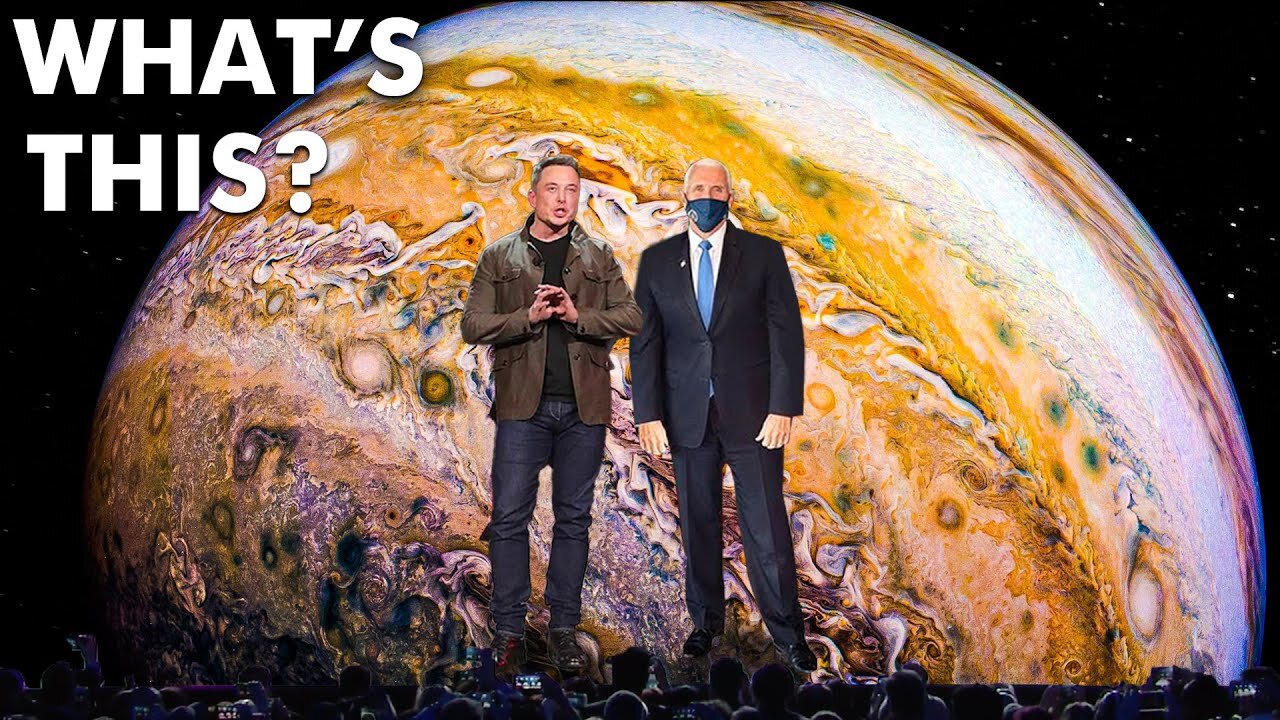Premium Only Content

Elon Musk & NASA's Terrifying NEW Discovery On Jupiter Changes Everything!
Jupiter appears tranquil from afar, with reddish-brown clouds floating and its
atmosphere emitting a distinct tint in the dark emptiness of space, but as
you get closer, this world becomes chaotic, scarred by dangerous storms.
With the help of measurements from the Juno spacecraft orbiting the planet,
scientists have constructed a 3D depiction of Jupiter's atmosphere for the
first time, and what these images reveal chills scientists to their bones.
In today's video, we'll be showing these Jupiter images that were discovered
and what's shocking about them, and SpaceX's involvement with NASA on
these Jupiter explorations. So, stay tuned to the end of this video, you don't
want to miss out on anything. Kindly subscribe and turn on the notification
button if you haven't already done so. Let's get started!
Jupiter, the king of the gods, was fittingly titled. It is the largest planet in the
Solar System, with the strongest magnetic field and the most moons. Though
astronomers have known about it since antiquity, the discovery of the
telescope and the development of modern astronomy have taught us a great
deal about it.
Close observations by automated spacecraft have been used to explore
Jupiter. Pioneer 10 was the first spacecraft to enter the Jovian system in
1973, and eight other spacecraft missions have been launched since then.
All but two of these missions were flybys that took extensive measurements
without landing or entering orbit, and they were all carried out by the
National Aeronautics and Space Administration (NASA). Because all missions
to the outer Solar System have employed Jupiter flybys, Jupiter has become
the most visited of the Solar System's outer planets. Juno, the second
spacecraft to enter the planet's orbit, arrived on July 5, 2016, and became
the second craft to do so in history. Sending a vessel to Jupiter is tough due
to the planet's severe radiation environment and huge fuel requirements.
In June, NASA announced that SpaceX had been chosen to fly a planned
mission to Jupiter's frozen moon Europa, a significant victory for Elon Musk's
company as it moves deeper into the solar system. The Europa Clipper
mission will launch from the Kennedy Space Center in Florida in October
2024 on a Falcon Heavy rocket, with a total contract value of $178 million.
Well, that's still in motion but with the help of Juno data, scientists have
constructed the first-ever 3D image of Jupiter's atmosphere.
Microwave light enables planetary scientists to peer deep beneath Jupiter's
colorful clouds, allowing them to better comprehend the weather and climate
in the warmer, darker, deeper layers. The spacecraft orbiting our solar
system's largest planet has revealed a more complete view of how the
planet's distinctive and colorful atmospheric features reveal information
about the activities occurring beneath its clouds.
Since 2016, the Juno mission has been circling our solar system's largest
planet, snapping photographs of its spectacular swirls. Jupiter has already
been detected to have lightning in the clouds, movement deep in the
atmosphere, and massive aurorae similar to Earth's famous Aurora Borealis.
Although Mars may appear to be the most popular place to look for life,
moons in the outer solar system, such as Ganymede, also have a lot of
potentials. Underneath their ice exterior shells, several frozen moons,
including Ganymede, Europa, and Enceladus, are thought to harbor oceans
of water. Ganymede, in particular, has a thick ice shell with rock fragments
buried in it and brilliant streaks across the surface, making it an attractive
and dynamic astronomical target. Ganymede also contains a magnetic field,
which is a vital protective shield for life.
One of Jupiter's most recognizable characteristics is the Great Red Spot. This
anticyclonic storm has a diameter of 24,000 km and a height of 12–14,000
km. It is located south of the equator. As a result, it has enough room to hold
two or three planets with diameters comparable to Earth's. And the location
has been known for at least 350 years, dating back to the 17th century when
it was discovered. Giovanni Cassini, an Italian astronomer, first discovered
the Great Red Spot in 1665. Astronomers theorized that it was a storm
caused by Jupiter's turbulent and fast-moving atmosphere by the turn of the
twentieth century. The Voyager 1 spacecraft viewed the Giant Red Spot up
close during its flyby of the planet in March 1979, confirming these
predictions.
Since then, though, it seems to have shrunk. In the 17th century, the size
was believed to be 40,000 km, almost twice as huge as it is currently, based
on Cassini's measurements. Astronomers are unsure when or if it will
completely vanish, but they are very certain that another one will appear
someplace else on the planet. Scientists have been fascinated by the
crimson vortex since its discovery nearly two centuries ago, and new findings
-
 10:21
10:21
Future Space
2 years agoScientists FINALLY Discovered a NEW Way To Travel Faster Than Light!
73 -
 8:50:58
8:50:58
Right Side Broadcasting Network
20 hours ago🎅 LIVE: Tracking Santa on Christmas Eve 2024 NORAD Santa Tracker 🎅
273K36 -
 2:48
2:48
Steven Crowder
22 hours agoCROWDER CLASSICS: What’s This? | Nightmare Before Kwanzaa (Nightmare Before Christmas Parody)
256K12 -
 33:49
33:49
Quite Frankly
19 hours agoThe Christmas Eve Midnight Telethon
68.7K7 -
 2:12:46
2:12:46
Price of Reason
18 hours agoAmber Heard BACKS Blake Lively Lawsuit Against Justin Baldoni! Is Disney CEO Bob Iger in TROUBLE?
24.4K10 -
 1:01:17
1:01:17
The StoneZONE with Roger Stone
13 hours agoChristmas Edition: Why the Panama Canal is Part of the America First Agenda | The StoneZONE
102K33 -
 18:12:15
18:12:15
LFA TV
23 hours agoLFA TV CHRISTMAS EVE REPLAY
123K14 -
 13:32
13:32
Scammer Payback
14 hours agoChanging the Scammer's Desktop Background to his Location
1.21K2 -
 4:21
4:21
BIG NEM
16 hours agoNikola Tesla's Secret to Cultivating Creativity & Genius
851 -
 15:03
15:03
The Anthony Rogers Show
1 day agoAnthony Rogers - Live at Cusumano's Pizza (Upstairs)
1671